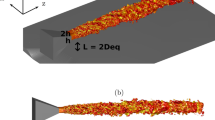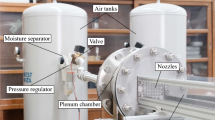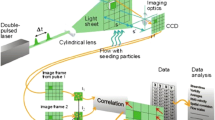Abstract
High-spatial resolution measurements of the velocity field of a supersonic jet impinging on a flat surface were conducted. To study the effect of the boundary condition, two nozzle outer geometries were investigated. The experimental results presented here are for a nozzle pressure ratio of NPR = 3.0 and a nozzle to plate spacing of \(Z/D = 3.5\). The flow fields of the corresponding cases show that although the general features of the flow are similar, the ambient air entrainment into the shear layer is different. This change in entrainment influences the rest of the jet structure.
Access provided by Autonomous University of Puebla. Download conference paper PDF
Similar content being viewed by others
Keywords
- Particle Image Velocimetry
- Shear Layer
- Digital Particle Image Velocimetry
- Nozzle Pressure Ratio
- Shock Cell
These keywords were added by machine and not by the authors. This process is experimental and the keywords may be updated as the learning algorithm improves.
1 Introduction
Interaction of a supersonic flow with a solid surface is important in aerospace and industrial applications. When a jet flow exits a nozzle with a pressure higher than the pressure of the surrounding area, an underexpanded jet forms. In this case, the pressure of the jet reaches the ambient pressure through a series of expansion and shock waves. Interaction of this unsteady supersonic flow with an impingement surface creates a high noise level at discrete frequencies. The unsteady flow and production of sound was first described by a feedback loop mechanism (Powell 1988). Powell (1988) hypothesized that the mechanism is initiated by instabilities in the shear layer at the nozzle lip. The instability waves grow in size and create large scale structures that travel downstream. When they impact the impingement surface, coherent large pressure fluctuations are generated that travel upstream as acoustic waves. At the nozzle lip, these acoustic waves force the shear layer which completes the feedback loop.
The authors have previously shown the cyclic nature of the impingement process and the closed loop instability mechanisms using two sets of high-spatial and high-temporal resolution schlieren images of an impinging jet (Mitchell et al. 2012) and acoustic measurements (Mason-Smith et al. 2015). In this study, high-spatial resolution two-component two-dimensional (2C-2D) measurements of the velocity fields of this phenomenon are presented. The important parameters that affect the flow structure and noise production are the nozzle pressure ratio (NPR), the nozzle to surface spacing (stand-off distance), the Reynolds number, the nozzle shape, and the impinging plate’s size and angle. The flow regime, instabilities, coherent structures, and the acoustic noise generation are sensitive to these parameters especially to the NPR and the stand-off distance. Therefore, it is important to address this fundamental problem at different conditions. In the present study, the measurements are performed along the axial-radial direction at a center plane of the jet. The flow structure for the nozzle pressure ratio of 3.0 and the stand-off distance of 3.5 for two boundary conditions are addressed in this paper.
2 Experimental Methodology
2.1 Jet Rig Facility
The apparatus used in this study was designed and developed based on the performance of an earlier LTRAC Supersonic Jet Facility (Mitchell et al. 2013). Compressed air at a pressure of approximately 7 bar and a temperature of approximately 20 \(^\circ \)C is transferred from the supply line into the mixing chamber of the jet facility using a high-pressure hose. The inlet compressed flow is regulated using a Fairchild (0–10 bar) high-flow pressure regulator with the pressure variation of approximately 1 \(\%\). The stagnation pressure in the plenum chamber is measured using a RS-461 pressure transducer with an accuracy of approximately 0.25 \(\%\). In this experiment, a converging nozzle with an inner exit diameter of 15 mm is mounted on the top of the plenum chamber. The nozzle which was manufactured using CNC machining of a single stainless steel block has a sharp lip with a thickness of 1.5 mm. A square piece of glass with a size of 15D \(\times \) 15D is used as the impinging surface. For seeding, a Vicount 1300 smoke generator is connected to the mixing chamber as shown in Fig. 1. The smoke generator provides a persistent and high seeding density with a nominal particle size of 0.2–0.3 \(\upmu \)m. The particle relaxation time of approximately 2.0 \(\upmu \)s is calculated experimentally based on the approach described in Mitchell et al. (2013). The corresponding effective particle diameter is approximately 0.6 \(\upmu \)m. To consider the effect of the nozzle lip two configurations as shown in Fig. 1 are investigated.
2.2 Optical Setup-PIV Analysis
The application of particle image velocimetry (PIV) to supersonic flows is accompanied with several challenges as described by Mitchell et al. (2011). However, upon addressing the issues, PIV can be a reliable measuring tool in this type of jet flow. In this study, a 12-bit Imperx B6640 camera with a CCD array of 6,600 px \(\times \) 4,400 px and a pixel size of 5.5 \(\upmu \)m \(\times \) 5.5 \(\upmu \)m is used as the imaging sensor. A two-cavity Nd:YAG pulsed laser (532 nm and 200 mJ per pulse) is used as the illumination source. An appropriate combination of spherical and cylindrical lenses is used to reduce the beam diameter and to produce a collimated laser sheet with a thickness of approximately 1 mm. A 200 mm Micro-Nikkor lens in combination with appropriate extension rings is used to obtain a magnification of approximately 0.65. The mean particle size is approximately 2 pixels using a F-number of 5.6. The depth of field estimation given in Table 1 is based on the diffraction limited image diameter, F-number, and the magnification (Raffel et al. 2007). 10,000 image pairs were recorded at a rate of 1.0 Hz. For the cross correlation of the image pairs, multi-grid cross-correlation digital particle image velocimetry (MCCDPIV) algorithm developed by Soria (1996) was employed. Multi-passing with a small final interrogation window at a high sub-pixel accuracy (using 2D Gaussian peak-fitting function) enables measurements with a high dynamic range. The PIV parameters are shown in Table 1.
3 Results and Discussion
Figure 2 shows an instantaneous axial velocity (u) field for each boundary condition at exactly the same operating conditions. The streamlines are shown in order to better visualize the air entrainment into the shear layer and the formation of the wall jet at the impingement surface. The normalization is done using the jet exit velocity (\(U_e\)) of approximately 315 m/s.
The flow features of the two cases appear similar, however, there are some evident differences in the entrainment and the flow features initiated at the nozzle exit. A periodic shock cell structure is observed in both the cases. The number of shock cells and position of the shock reflection points at the jet boundaries are similar. The maxima of the out-of-plane vorticity (not shown here) occur in the shear layer at the jet exit. The vorticity of the opposite sign is observed when the jet hits the wall.
The first- and second-order statistics (not shown here) also show different structures. Although there are similarities in the two jets, there are differences in turbulence intensities. In configuration 1, velocity fluctuation levels near the shock cells appear to be lower than the corresponding regions in configuration 2. This could be explained due to the fact that the ambient air entrainment into the shear layer is easier in Fig. 2a in comparison to Fig. 2b. The enhanced air entrainment resembles the effect of steady flow injection into the shear layer using microjets in order to reduce the flow unsteadiness (Kumar et al. 2013).
4 Concluding Remarks
An ultra high-spatial resolution measurement of an impinging supersonic jet was performed. The complex flow structure that is a resultant of interaction of the jet with the surface and acoustic field was investigated at two nozzle configurations. It has been shown that although the number of shock cells and their spacing are similar, the air entrainment into the shear layer and turbulence intensities are different.
References
Kumar R, Wiley A, Venkatakrishnan L, Alvi F (2013) Role of coherent structures in supersonic impinging jets. Phys Fluids 25(7)
Mason-Smith N, Edgington-Mitchell D, Buchmann N, Honnery D, Soria J (2015) Shock structures and instabilities formed in an underexpanded jet impinging on to cylindrical sections. Shock Waves 25(6):611–622
Mitchell D, Honnery D, Soria J (2011) Particle relaxation and its influence on the particle image velocimetry cross-correlation function. Exp Fluids 51(4):933–947
Mitchell D, Honnery D, Soria J (2012) The visualization of the acoustic feedback loop in impinging underexpanded supersonic jet flows using ultra-high frame rate schlieren. J Visual 15(4):333–341
Mitchell D, Honnery D, Soria J (2013) Near-field structure of underexpanded elliptic jets. Exp Fluids 54(7)
Powell A (1988) The sound-producing oscillations of round underexpanded jets impinging on normal plates. J Acoust Soc Am 83:515–533
Raffel M, Willert C, Wereley S, Kompenhans J (2007) Particle image velocimetry, a practical guide, 2nd edn. Springer, Berlin
Soria J (1996) An investigation of the near wake of a circular cylinder using a video-based digital cross-correlation particle image velocimetry technique. Exp Therm Fluid Sci 12(2):221–233
Acknowledgments
The financial support to conduct this research by the Australian Research Council is gratefully acknowledged. This research was undertaken with the assistance of resources from the National Computational Infrastructure (NCI), which is supported by the Australian Government.
Author information
Authors and Affiliations
Corresponding author
Editor information
Editors and Affiliations
Rights and permissions
Copyright information
© 2016 Springer-Verlag Berlin Heidelberg
About this paper
Cite this paper
Amili, O., Edgington-Mitchell, D., Honnery, D., Soria, J. (2016). Interaction of a Supersonic Underexpanded Jet with a Flat Plate. In: Zhou, Y., Lucey, A., Liu, Y., Huang, L. (eds) Fluid-Structure-Sound Interactions and Control. Lecture Notes in Mechanical Engineering. Springer, Berlin, Heidelberg. https://doi.org/10.1007/978-3-662-48868-3_40
Download citation
DOI: https://doi.org/10.1007/978-3-662-48868-3_40
Published:
Publisher Name: Springer, Berlin, Heidelberg
Print ISBN: 978-3-662-48866-9
Online ISBN: 978-3-662-48868-3
eBook Packages: EngineeringEngineering (R0)






